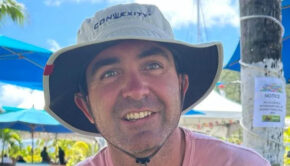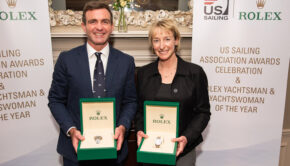Taking steps in the right direction
Published on February 4th, 2015
After winning the first In-Port race, Team Alvimedica felt ready for the Volvo Ocean Race to begin, but legs one and two would show them otherwise. So the team got to work, assessing their onboard operations and looked hard at how other boats were set-up.
Improving throughout the race is vital for success, and Alvimedica took a positive step by finishing third in leg three from Abu Dhabi to Sanya. Scuttlebutt editor Craig Leweck checks in with skipper Charlie Enright for an update on their progress…
To what do you attribute your progress?
It really is a lot of small things, but for starters, my relationship with our navigator Will Oxley is definitely strengthening. We’re learning how to play off each other, what our strengths and weaknesses are, how best to allocate our time. It is important that we can be decisive when needed, and this leg showed that for us.
Along the Pakistani Coast, we didn’t have a problem breaking from the group and being the first guys to lead offshore, which proved to be a good move on the fleet. When in the Malacca Strait, we caught ourselves confidently leading in directions as opposed to just hedging, which was a healthy change. Going out of Singapore we positioned ourselves amid the fleet so we could sail a mode that we think is one of our strengths upwind and breeze. And then when short tacking along Vietnamese coast, we again made gains in a situation where a leg ago I don’t think we would have fared nearly as well..
Our progress is due to the systems now in place, the allocation of resources, the way we managed the watch system, the stack… everything. We went in with a battle plan and we were able to execute it with efficiency and confidence.
Good decision making is usually a result of being fast.
I think it’s very situation-dependent. We still have our speed issues in light air running, and tend to slip back when the conditions don’t suit our strengths. But nobody’s fast as Dongfeng in under 13 knots with the A3, which is what allowed them to jump ahead into their own weather to win leg three. We can also learn from Brunel which is quite good with the masthead zero, and Abu Dhabi is very well-rounded and perpetually fast, which allows them to execute conservative tactics.
Which team are you most curious about?
Right now you’d have to say Dongfeng. They break the most stuff….are they pushing the hardest? Is it the certain set-ups they have? I think everybody is most curious about what they have going on.
Each team is required to use the Automatic Identification System (AIS). How can this help with boat speed improvement?
It certainly doesn’t hurt, but all it really tells you is whether you’re fast or slow. As long as we are within range of another boat (8-10 miles), we can use AIS to remain in touch to measure performance, but then it is on us to sort out the reasons for speed differences.
If you’re going upwind in 18 knots and you’re gaining on everybody, then you know you got a good mode and should record those settings. Just the same, if you’re going downwind with the A3 and you’re slow, then that’s where you got to put in your time. That’s where you’ve got to figure it out. AIS will tell us another boat’s direction and speed, but not what sails they are using, where their stack is, how their tanks are filled, etc.
But making progress must feel good.
Our strength right now is stability sailing and this past leg had pretty light conditions, so posting our best finish result in conditions that are not our strength is very positive. There were times along the Indian coast when we were hemorrhaging miles all the way south, so the light air running is an area we must work on. But by grinding it out and staying in touch, we gave ourselves the opportunity to make some pretty good navigational and tactical decisions as we got to some of the various features of the latter part of the leg, and by doing those things confidently is what helped us separate ourselves towards the end of it. But we still have a lot of work to do.
The tag line of this race for us is everybody has to deal with the same variables. It’s the one design system and the shared maintenance boatyard concept. Everybody is given the same tools and everybody is racing on the same course. So despite the elements of randomness, and leg three had a lot of randomness, it’s random for everybody and each team takes a turn at getting kicked. And despite the conditions, the boats that sailed the best, finished the best in this particular leg regardless of what the obstacles were. But we want to consistently be one of those boats.
You mention elements of randomness… share some of the randomness you encountered on leg three.
Short tacking up the Vietnamese coast, you look west and you’d see a bunch of lights and you’re like, “Okay, that makes sense, that’s land.” And then you’d look to the east and you see a bunch of lights and you’re like, “There’s that many fisherman out here. That is absolutely insane.” And we saw a mother ship with these guys floating in what looked like a basket with an oar, and they were all fishing. We’re bombing along at 12 knots and these floaters have only a flashlight to defend themselves. I think for us, that’s scary because it’s like, “What can I do for this guy if I hit him?”
But the biggest concern was the commercial traffic, the heavy metal. A big merchant ship that’s going 20 knots in the Malacca Strait, and we’re drifting at .5 knots and unable to get them on the radio. That makes it hard for me to sleep. Running over a fishing net, yeah, that’s annoying. There’s so many of them, everyone’s going to have their turn.
All in all, the course was pretty crazy, so for all the teams to get through unscathed is pretty remarkable.
Background: The 2014-15 Volvo Ocean Race began in Alicante, Spain on Oct. 11 with the final finish on June 27 in Gothenburg, Sweden. Racing the new one design Volvo Ocean 65, seven teams will be scoring points in 9 offshore legs to determine the overall Volvo Ocean Race winner. Additionally, the teams will compete in 10 In-Port races at each stopover for a separate competition – the Volvo Ocean Race In-Port Series. The fourth leg, from Sanya, China to Auckland, New Zealand (5,264 nm), begins Feb. 8 with an ETA of Feb. 25-Mar. 5. Race website: http://www.volvooceanrace.com/en/home.html









 We’ll keep your information safe.
We’ll keep your information safe.